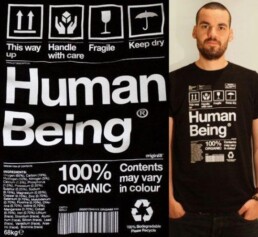We Need Diverse Books

Written by Anna Szpakowska
Professional Development Lead at Lyfta
The outpouring of shock, disgust and despair surrounding the murder of George Floyd this year rightly drew our attention to the discrimination suffered by so many on a daily basis. It also drew our attention to the institutional racism pervasive in much of our society. This heightened social awareness led to discussions of diversity in education, with calls for the history curriculum to include black British history and many English teachers sharing their recommended diverse reading lists or schemes of work online. In fact, some young people started a petition to ask the government to include The Good Immigrant and Why I’m No Longer Talking to White People About Race on the GCSE English Literature specification.
It was heartening to see so many educators impassioned to provide an education to young people which directly tackled issues of discrimination; it’s wonderful to work for a profession that not only wants to provide young people with knowledge and skills but also wants to make the world a better and more just place.
This is not the first time something like this has happened. In fact, in 2019, Edexcel were forced to add more texts from black, Asian and other minority ethnic writers to their GCSE Literature specification, after complaints about there being ‘too many dead white men’ on the reading list. This decision whilst perhaps well-intentioned, was met with disappointment from educators suggesting that the choices of texts, added by Edexcel, were not challenging enough. And, as Diane Leedham pointed out ‘As with all the exam boards in 2014, it’s clear that the people choosing the set texts that they frame as ‘diverse’ don’t have much knowledge of diaspora literature’.
Nevertheless, according to statistics from 2019, only 12.6% of students sitting an English Literature GCSE in 2019, sat the Edexcel qualification. In fact, the largest percentage (85%) of pupils sitting an English Literature GCSE in 2019 sat the AQA qualification. And figures from the AQA Examiner’s Report in 2019 show that of the most popular texts studied by all centres completing the AQA English Literature GCSE, all of the authors were white men, very few of the characters were women and none of the characters were black or Asian. The dilemma for educators then, is not only are the exam boards not providing enough suitable texts to truly reflect the experiences of most of us in society, but that the majority of schools themselves continue to choose to teach texts written by dead white men.
As teachers of English literature, we are the gatekeepers of books and literature accessed by many young people. It is, therefore, our moral obligation to expose young people to a wide variety of texts that provide them with a range of experiences, voices and characters. As Botelho and Rudman explain (expanding on Sims-Bishop’s metaphor of windows, mirrors and doors):
‘Children need to see themselves reflected so as to affirm who they and their communities are. They also require windows through which they may view a variety of differences…. Literature can become a conduit- a door- to engage in social practices that function for social justice’
Where are all the women?
For the purposes of this post, I will focus my thoughts on female writers, characters and issues of sexism and misogyny. That is not to say that I place more value on the inclusion of female writers and characters than I do on black authors and characters, gay authors and characters or authors and characters with disabilities, for example. I just feel that as a woman, I am best placed to discuss the issue of women in literature.
So, why then, in 2020, do we have to have a discussion about young people accessing texts written by and about women? And, why is it so important anyway? Aren’t women equal after all? Unfortunately, the answer is a resounding no. Despite the equal pay act being introduced fifty years ago this year, the UK’s gender pay gap is still 17.3% with the World Economic Forum reporting that it will take 202 years to close this gap. As well as this, statistics gathered from 2019, show that the number of women and girls murdered in 2019 rose by 10% on the previous year, to take it to the highest figure since 2006. It’s clear there’s much more work to be done before we can claim our equality.
With no shortage of female authors writing about the female experience, why do we continue to choose to teach texts written by and about men? The myth of the superiority of the ‘great’ English literary canon has a lot to answer for but what worries me a great deal is that teachers continue to buy into this myth. By continuing to teach these texts – and more often than not, attempting to mirror the GCSE curriculum at Key Stage 3 too – we perpetuate the notion that one voice (the white male) is superior to everyone else’s.
And, yes, it’s true that children may be reading plenty of texts by women and about women in their own time. But, when they haven’t been taught the critical skills to unpick the sometimes-sexist depiction of female characters, I fear that we are at risk of inculcating a generation of young people with sexist ideals.
Both young women and young men need to see a variety of female characters. They need to be able to discuss issues of sexism. It’s not our job to police what they read and discourage them from reading books such Louise Rennison’s Angus Thongs and Full Frontal Snogging because, as Kimberley Reynolds explains it depicts female characters who are ‘only interested in friends, fashion and fun’. But it is our job to show young people alternatives and teach them to read critically. Characters like Starr in Angie Thomas’ The Hate U Give, for example show a passionate, intelligent, strong and socially responsible young woman. Or, Dana in Octavia Butler’s Kindred could provide opportunity for discussions of gender and race whilst also providing them with an insight into the Antebellum South and the science fiction genre too. For teenagers (some of whom will already be sexually active), it’s important to address the issue of sexual assault. Books like Amber Smith’s The Way I Used to Be could be helpful in achieving this.
What’s key here is that teachers clearly have the passion, the willingness and the desire to teach a wider variety of authors and texts. I hope the passion and impetus we have garnered this year does not disappear and our calls for a more diverse reading list can be implemented. But what must also accompany these reading lists and all literacy education is critical discussions about how and why characters are presented in certain ways.
Why Diversity Matters in Education: “The rise of an internationally-minded child.”
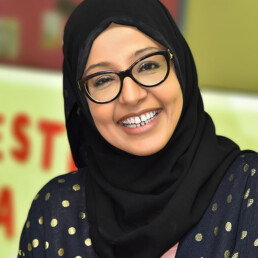
Written by Fatma Khalid
A lot has been written recently about diversity, especially in education. Whilst diversity has been “entertained” by a lot of administrators and specifically policy makers into bringing the novelty idea to practice, there is still a lot to be done in terms of making our society and specifically our educational sector more diverse.
Majority of times I have seen students, even my own children, being confused about their culture and identity specifically for children who are born and raised in countries that are not their countries of origin. The implications of this reaches out to sometimes loss of identity or even worse the breed of inferiority that we find most common even here in the UAE where certain cultures and nationalities are often viewed as being better because of how they are portrayed or advocated. This is further challenged by the market niche in the UAE which gravitates towards recruiting teachers of certain nationalities further compromising the practice or need for diversity and inclusivity. Children grow up feeling that the most knowledgeable and people holding high offices are isolated to only ‘a certain kind’ which itself is a huge impediment to ambition and self-esteem.
Although schools have tried to review their curriculums to include enriched activities that promote culturally diversified programs, little has been done to support world-wide inclusiveness or build a truly “international minded” child. Curriculums majority of times are still country bound; where they cover history or cultures to that particular country as compared to covering world history and include studying cultures of the world so children can truly build acceptance and respect and be aware of other cultures that are unique and significantly different to theirs; this is what after all is defined as an “international minded child”. How else can a child build compassion or become a global citizen if he/she spends all their lives thinking there was only one culture or history that was worth studying and understanding.
All efforts need to be in place to ensure that all children’s cultures are represented in curriculum which is highly recommended for a highly inclusive society such as the one here in the UAE. Culture awareness cannot be left for isolated occasions such as the most commonly celebrated “international day” where children and parents are encouraged to bring their traditional food and dress in their traditional clothes, then tribute done and the rest of the year, children go back to studying the curriculum (country bound) history. When we have made technology a mandate, cultural diversity too holds importance and should be integral and be embedded in our core curriculums.
Moreover, ensuring that our teams are made up of qualified individuals from different nationalities increases the opportunity for children to learn and understand cultures from multiple countries that most importantly also represents them. Curriculums are consequently enriched with creativity and increased global perspective for a truly diverse society that aims to understand, acknowledge and accept that although we are different, we are fundamentally the same kind…
The human kind.
The Role of Wellbeing & Resilience in Diversity
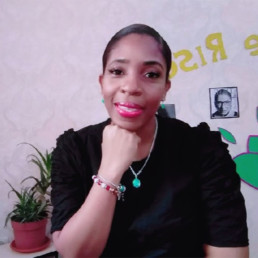
Written by Tasha Fletcher
Lead Primary Teacher in KS1
Resilience “an innate capacity to rebound from adversity and change through a process of positive adaptation. For young children and adolescence, resilience is a fluid, dynamic process that is influenced over time by life events, temperament, insight, skill sets, and the primary ability of caregivers and the social environment to nurture and provide them a sense of safety, competency, and secure attachments.” National Resilience Resource Center
International and local schools around the world are culturally, ethnically, and racially diverse. Now more than ever there needs to be a conscious shift in the role that wellbeing, mental health and resilience play in diverse classrooms.
But how can we as educators begin making this a priority in our classrooms?
What are some of the signs we should look out for?
What role can we play in ensuring our students feel valued and safe regardless of their ethnic backgrounds?
What is culture?
Culture shapes society’s attitudes, beliefs and behaviours. Every individual is a part of multiple cultural groups, based on several factors such as; race, ethnicity, faith, country, type of work, level of education, physical ability or disability status, sexual identity and so on.
If you work with young children or teenagers that have different cultural backgrounds from your own, there can be additional communication challenges, as teachers we face these challenges every day. Many communities have agencies that provide services for specific cultural and ethnic populations.
How is wellbeing and resilience linked to diversity?
Wellbeing and resilience play a huge role in diversity, especially in today’s classroom where the cultural differences that exist between teachers and their students/students and their peers are numerous.
Diversity may exist with regard to race, culture, religion, language, sexual orientation and socioeconomic status. Parents/guardians, teachers, caregivers, extended family members and other adults in children’s lives have an important role to play both in their responsibilities and opportunities to model ways for children and teenagers to feel safe, connected, valued, capable, respected and grow in resilience.
Unfortunately, within many school systems, a lot of students are faced with discrimination from other students as well as staff every day, due to a lack of understanding or empathy with regard to the variations in beliefs, practices, and values of different cultural groups. Since ethnic minority children have higher rates of suspension/expulsion, special education placement and school dropout, it is evident that numerous disparities exist within our education systems.
There are instances where students, for a variety of reasons, may face more challenges due to adversity, trauma or unsafe living conditions at home. On the other hand, children can grow up in completely nurturing environments and still, because of genetics, brain chemistry or a special educational need, have an emotional, mental health or behavioural disorder.
The role of culture
Culture has a significant impact on the beliefs and attitudes surrounding child development, identification of problems and judgment about the best way to intervene when problems do occur. Furthermore, each of us operates within an individual culture, which espouses specific beliefs that determine how we interact with others and interpret their actions.
Cultural variations in expressions of behaviour may contribute to misunderstandings and conflict, which can be decreased through enhancing multicultural awareness. And while risk is a contributing factor for poor outcomes, it is not a given because educators, parents/guardians and other adults entrusted with the care of young children and teenagers can help all children gain and maintain a sense of their own strengths and abilities (if they know how to and should receive support from the relevant authorities; DSO, counsellors, psychologists, child and wellbeing services etc).
So what can we do as educators and parents to promote diversity and inclusion in schools and communities?
Recognise the cultural diversity and uniqueness of students and learn as much as you can about your students’ cultural background by spending time with your students and getting to know them. (This is especially good to do at the start of the year) and a simple “All about Me” activity is a great way to start. Some teachers may argue that this activity is geared towards younger children, but as a teacher creativity is at the heart of what we do. You can turn this into a carousel activity of guess who clues for Middle School or KS2 children and staff around the school, in the gymnasium or sports field.
You can start a class mystery blog for Secondary students in which each student writes a blog about him/herself (I would suggest giving a minimum word limit but not a maximum).
The goal will be to feature a new student each week and the class has fun guessing who it may be while learning about each other.
Whatever activity you choose to do, don’t just collect the information, use that information to help your students and create successful relationships in which your students feel valued as a member of your class.
Recognise that socioeconomic and political factors have a significant impact on the psychosocial functioning of culturally and ethnically diverse groups
Develop an awareness of your own cultural and ethnic background and acknowledge differences in the culture between you and your students.
You can do this by incorporating instructional strategies into your school’s curriculum that are sensitive to cultural differences such as: text books, planned activities and field trips, print rich environments which can include key/everyday words which represents the various ethnicities of students in your classroom or invite students to contribute something from their different cultural backgrounds towards the classroom displays to help build a sense of belonging, feeling valued and a voice.
Promote tolerance and understanding of cultural differences – as a teacher or parent you can promote this in many ways:
Incorporating fun learning projects that teach about diversity, wellbeing, mental health and resilience through.
PSHCE discussions or peer and group collaborations using task cards. I have created some wonderful resources which can be used to help children recognise the value they bring to the group and to understand the role they play in keeping well and mentally healthy for both primary/early years and middle school/upper primary.
International day celebrations – children, staff, parents and members of the community can contribute to events like this to promote diversity, equality and respect.
Teachers and children could plan activities together with their parents to showcase a country for a day/week. Together you may all choose to dress up in the traditional clothes of that specific country/culture for a day, learn a new song, poem or read aloud in the language and present it. Inviting guest speakers, or watching a film together are also other hands-on ways you can promote and celebrate diversity in your classroom or school.
But why stop there?
As a teacher you can work together with schools in other countries and collaborate on a mutual interest with your students. The aim here is to expose the children to cultures and ways of doing things that are different from their own by instilling tolerance, respect, reflection and developing the understanding that although some people may look, dress, and speak differently than they do they each have a uniqueness that should be valued and celebrated.
What can we do as educators, parents/guardians and caregivers to support resilience?
Instil in children a sense of values while respecting other viewpoints.
Encourage good nutrition, exercise, diet and physical fitness for example you can include yoga or breathing exercises as part of your brain breaks with students during class times.
Teach gratitude and a recognition of blessings in life, as teachers we probably do this every day. We often ask our students to reflect on their lesson by checking their targets or filling in smiley faces.
Why not include wellbeing and resilience as part of that gratitude too?
You could create a reflective/wall of gratitude which could be placed on a wall or door to the exit. Students can then write something they were thankful for at the end of the year and add it to the wall as they leave for the day.
Another way to incorporate this could be creating a wall of gratitude in a padlet and students can fill in one thing on the wall as a home activity. It can also be a useful sharing tool for weekend activities.
Provide opportunities for friendships and a social support system to develop. As adults we know how important it is to have good, strong and dependable social groups from adults we trust and can count on.
The same goes for children and teenagers, as adults we should ensure that the children entrusted in our care know where to go to for help if they need it and are not afraid to ask for it too. Encouraging opportunities for social support systems with friends and trusted adults is a good way in which to do this. School counsellors, homeroom teachers, social support groups within the school or community are all ways in which we can promote this.
Try to encourage children’s ability to figure out life through trials, error and success. A lot of children because of cultural norms, low self esteem or socio economic status are under pressure “ to not accept failure” or grow up hearing that failure is unacceptable from the adults who are sworn to protect them.
Failure is a big part of success and growth, therefore young children and teenagers NEED to know that it is okay to fail. After all it is how we learn, and acceptance of that failure is paramount to the next step which should inevitably be success.
As adults it is equally important to take care of ourselves too.
Find ways to take care of yourself based on what you enjoy doing, for me going on long walks in nature or reading usually does the trick.
Be mindful of how your thinking is helping or hurting your situation. Always be careful of your thoughts, for what you believe have the tendency to become.
Find comfort in the small things and gratitude in your own accomplishments and contributions. This can be as simple as acknowledging out loud something you are successful at or grateful for each day.
Be a lifelong learner, find enjoyment through learning new ideas.
Promote ways to feel competent, connected, and to have life satisfaction.
And finally Instil a sense of pride in your family as well as your cultural traditions and rituals.
About the author:
Tasha is a lead primary teacher in KS1| mum of two boys | Designated Safeguarding Officer | ELT Materials writer. With a specialisation in Early Childhood and Psychology, she has more than 16 years of experience in young learner education, starting in pre-primary and primary in Trinidad & Tobago (Caribbean) before specialising in TEFL to young learners. She has lived and worked in 9 countries across the world, working in teaching, teacher training, assessment and educational development. When she is not teaching, she enjoys spending time with her family playing football, basketball and nature walks.
Black Lives Matter: Then, Now & Always
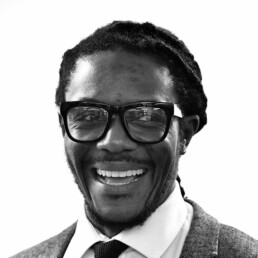
Written by Wayne Reid
Professional Officer & Social Worker
The murder of George Floyd is the latest in a long line of atrocities and brutalities endured by the global Black community. This has a long history. Longer than is sometimes convenient for honest acknowledgement. I notice some commentators are referring to George’s ‘death’, which is a dilution of what occurred. George was brutally murdered by a Police Officer and the world has seen the evidence.
The context to George’s murder is emotive and cumulative: the Amy Cooper ‘race grenade’; endless examples of police brutality cases in the US and UK; modern-day systems of oppression and the historic and ongoing the suppression of the effects of slavery and colonialism in mainstream education. These factors can accumulate and create an acute sense of anger and rage. These emotions can manifest into civil disorder and criminality. It has been evidenced that anarchic extremists are infiltrating protests to covertly fuel acts of looting and violence, which is then reported by the media in such ways to discredit the protesters. This detracts from the causal factors that have triggered the protests – and if we want to discuss looting, how about the longstanding looting of Africa’s natural resources?
As a Black British male social worker, I write this article on Black Lives Matter ‘wearing numerous hats’, as this issue affects me deeply both personally and professionally. Clearly, my opinion cannot and should not be understood as representing all Black and ethnic minority people/practitioners. We are not a homogenous group. It was important to me for my employer, the British Association of Social Workers (BASW), to publish our organisational position statements before I wrote this article, as I refuse to be the tokenistic ‘Black voice’ of BASW. I’m one of many Black voices in social work. It is my reality, that my role enables me to be heard more broadly than others.
I’m immensely proud of the authenticity and candour of BASW’s statements responding to George’s murder and in support of the fight against racialised discrimination.
Those who follow me on Twitter, or who are on my mailing list, will have observed my campaign to educate, empower and equip Black and ethnic minority people – and importantly our allies – with various information and resources.
On occasions, I have been outspoken about the delayed/weak position statements and responses from prominent social work leaders and organisations. Given that social work’s core values and ethics are deep-rooted in anti-oppressive practice and social justice, this eventuality has been particularly disappointing for me and many others within the profession. Sadly, these values and ethics appear sometimes to have been taken for granted, diluted or ignored in recent years/decades. Perhaps austerity has desensitised us? Overall, I’m sure Black and ethnic minority social workers and service-users will welcome the late (if weak) acknowledgements and platitudes from some of the social work elite. The statements will send a necessary message to employers and other stakeholders across the profession about the relevance of current world events to social work policy, practice and education. However, I think some of the statements could be strengthened by providing a clearer commitment to systemic reforms to eradicate all forms of racism through specific, measurable, achievable and realistic targets.
During the furore surrounding George’s murder, some individuals/organisations have recoiled at the suggestion they may be racist. “I’m not a racist!” is the common response. The accusations seemingly worse than the facts. I would argue that racism is not an absolute mindset, instead it’s a rather fluid one. There are degrees of racism. I imagine very few people reading this article would identify with extreme right-wing neo-Nazi racism, but many will have stereotypical views about certain ethnic groups which they project in everyday situations (if they are honest/self-aware). There is a structural and lazy acceptance, that ‘lower level’ prejudice and oppression are somehow separate – with the former being considered a less important issue. However, I believe if this changed it would engender a real decrease in the overt, violent forms of ‘race-related hate’.
In my view, the spectrums of white privilege and white supremacy are also broad – not absolute. This graphic here best describes my views. Fundamentally, there are a range of behaviours and oppressive systems that are socially acceptable, which we must address and redress to tackle racism effectively in all its ugly manifestations. For example, the statement ‘all lives matter’ is covert racism, as it ignores the history and current circumstances of Black people globally. Physical colonisation and slavery may no longer be acceptable or legal, but colonisation and slavery of the mind has been the norm since their abolition. Black lives matter applies then, now and always.
The recent misdemeanours of Dominic Cummings show us there are clear double standards; not just from a class perspective (which was perpetuated by the media) – but also through the lens of white privilege. I wonder how Raheem Sterling would have been portrayed flouting the lockdown rules.
Labels/terms such as Commonwealth, ‘hostile environment’, and ‘BAME’ need to be re-examined. BAME does not describe who I am. BAME is a clumsy, cluttered and incoherent acronym that is opportune for categorising people of colour as a homogenous group – when we quite clearly are not. Of course, I cannot speak for all people of colour. I understand that ‘BAME’ can be operationally helpful when exploring the overarching effects of all things racist. However, it misses so much nuance and subtlety, that it can be seized upon by those who wish to deny racism as a white problem. Routinely, I hear people comfortably stating that BAME people “can’t even agree amongst themselves”. This sloppy reductivism, leads to terms being invented such as ‘Black and Black’ crime. I have not heard about “White on White” crime – ever.
Some quarters consider having a small minority of people from Black and ethnic minority groups who reach positions of power (including within the current Cabinet), as progress, in and of itself. I respectfully disagree and would go so far as to say it is actually unhelpful in this case. I think a contingent of these people only seem to identify as being people of colour when it is expedient. Often, they have championed policies that in fact would have previously disadvantaged their own families – which is basically ‘pulling up the drawbridge’ and ‘morally bankrupt’. In some ways it is worse than having a ‘conventional racist’ at the helm. To quote Malcolm X: “I have more respect for a [person] who lets me know where [they stand], even if [they are] wrong, than the one who comes up like an angel and is nothing but a devil.” Politician’s have form for allowing their personal ambitions to override ethics and morality. Their denials can play beautifully into the hands of those who seek to maintain the existing order. As black and ethnic minority representation is disproportionately very low, these people do not necessarily use their power for good and structural inequalities remain unchanged.
At this current juncture in race relations, there has been much discussion about how ‘white allies’ can be ‘anti-racist’ and supportive to the cause. Of course, allies can be personal and/or professional. So, what is really behind those awkward smiles and sugary sympathy? Actions most definitely speak louder than words. It’s time for all well-intentioned platitudes and recycled rhetoric to be converted into meaningful activism and ‘root and branch’ reform. This weblink will provide allies with relevant resources on their journey.
‘Blackout Day’, on 07/07/20, is when Black and ethnic minority people (and their allies) will not spend any money (or if they must, only at Black businesses). This is so important, as it sends a strong message to the capitalist elite in the only language they understand – money. See this video for more information on ‘Blackout Day’. We must build on this impetus and momentum to be taken seriously.
It is imperative that social workers evaluate their roles and (moral and regulatory) responsibilities. Current race relations require social workers to be proactive and do our homework to stay contemporarily astute as allies to Black and ethnic minority colleagues and service-users. There are various opportunities through BASW to develop your expertise in this area with our Equality, Diversity & Inclusion Group, events, branch meetings and training programmes. Also, I will be leading a Black & Ethnic Professionals Symposium (BPS) for BASW members in the coming weeks, so do contact me at wayne.reid@basw.co.uk or @wayne_reid79 – if this is of interest.
We all know that organisations are at times avoidant of these issues, but as social workers we must recognise that silence on racism is complicity with the oppressors. BASW will not remain silent on this issue and we implore you to do the same.
‘One world, one race… the human race!’
Inclusive Allyship

Written by Hannah Wilson
Founder of Diverse Educators
Allies:
noun. a state formally cooperating with another for a military or other purpose.
verb. combine or unite a resource or commodity with (another) for mutual benefit.
Allyship:
A lifelong process of building relationships based on trust, consistency, and accountability with marginalized individuals and/or groups of people. not self-defined—work and efforts must be recognized by those you are seeking to ally with.
Why do we need to be Inclusive Allies?
We are all humans. We are all equal. We all need to check our privilege. We need to empathise with the struggle that some people go through. We need to be aware of the obstacles and the barriers in the way of some people on their journey. We need to be aware of the impact of prejudice and discrimination.
#HeForShe and #WhiteAlly are two labels I have heard used in the last few years as the grassroots communities encourage supporters to join their movements for change.
Much like #DiverseEd aims to make connections between the different communities, we need a term to capture everyone who works with others to. At the #CollaborativeSupportForWomen event and our #DiverseEd event we have promoted the idea of Inclusive Allies:
Amy Ferguson spoke about Allyship at the Collaborative Support for Women event and the recording is here.
Patrick Ottley O’Connor spoke about Allyship at the Virtual Diverse Educators event and the recording is here.
Allyship is a process, and everyone has more to learn. Allyship involves a lot of listening. Sometimes, people say “doing ally work” or “acting in solidarity with” to reference the fact that “ally” is not an identity, it is an ongoing and lifelong process that involves a lot of work.
Inclusive Allyship is:
Men working alongside women to smash glass ceilings and advance gender equality.
White people working alongside people of colour to smash concrete ceilings and advance racial equity.
Heterosexual people working alongside Lesbian, Gay, Bisexual, Transgender, Queer and Intersex people to smash the gay glass ceiling.
Able-bodied people working alongside disabled people to smash the glass disability glass ceiling.
How do we support as Inclusive Allies?
Allyship is about confronting othering, ‘isms’, privilege, prejudice. Allyship is about standing up and speaking out on social justice issues.
I found a great website called Diversability which encourages us to think differently about allyship and I have lifted the below advice from The Guide to Allyship.
How to be an Inclusive Ally:
Take on the struggle as your own.
Stand up, even when you feel scared.
Transfer the benefits of your privilege to those who lack it.
Acknowledge that even though you feel pain, the conversation is not about you.
Be willing to own your mistakes and de-centre yourself.
Understand that your education is up to you and no one else.
Being an Inclusive Ally is about white people, straight people and able-bodied people being aware of our privilege. We need to do the work, the inner work, to reflect, to learn and to grow. As an Inclusive Ally there are different roles we can take on to move the conversation and the agenda for diversity, equity and inclusion forward.
7 ways to be an Inclusive Ally:
The Sponsor
The Champion
The Amplifier
The Advocate
The Scholar
The Upstander
The Confidant
Allyship will not always be comfortable. We need to get comfortable with being uncomfortable. We need to check our privilege and realise that our momentary discomfort is not comparable to the long-term discomfort that people live with. Trauma and tragedy are the lived experienced for many people.
The last few months have been emotionally-charged. Our colleagues, our communities and our children who come from diverse backgrounds have potentially been deeply affected by the tragic murder of George Flood. I saw potentially as we cannot assume that everyone has experienced and responded to the most recent Black Lives Matter incident in the same way. To deepen your understanding I recommend reading this article on How to be an Ally During Times of Tragedy.
Becoming and being an Inclusive Ally requires intention, commitment and action. We need to lean in to this space, no matter how hard, how painful and how uncomfortable it is.
What do we do to be Inclusive Allies?
THE DO’S
Do be open to listening
Do be aware of your implicit biases
Do your research to learn more about the history of the struggle in which you are participating
Do the inner work to figure out a way to acknowledge how you participate in oppressive systems
Do the outer work and figure out how to change the oppressive systems
Do use your privilege to amplify (digitally and in-person) historically suppressed voices
Do learn how to listen and accept criticism with grace, even if it’s uncomfortable
Do the work every day to learn how to be a better ally
THE DON’TS
Do not expect to be taught or shown. Take it upon yourself to use the tools around you to learn and answer your questions
Do not participate for the gold medal in the “Oppression Olympics” (you don’t need to compare how your struggle is “just as bad as” a marginalized person’s)
Do not behave as though you know best
Do not take credit for the labour of those who are marginalized and did the work before you stepped into the picture
Do not assume that every member of an under-invested community feels oppressed
For teachers and those working in education we need to consider the impact we can have in our classrooms and our schools. We need to be the change in teaching tolerance and acceptance, we need to celebrate diversity and create a sense of belonging for all identities. We need to ensure that our environments and physically and psychologically safe for everybody. We need to have the big conversations about the world to equip everybody with the knowledge, skills and values to navigate society.
There are 10 Things You Can Do to be an Ally:
Listen
Get educated
Get involved
Show up
Speak up
Intervene
Welcome discomfort
Learn from your mistakes
Stay engaged
Donate
There are some tips here on how to be a teaching tolerance ally here.
For leaders, being an ally is a journey. Even the most inclusive leaders admit they have room to grow. The work never stops, yet it is your choice to start, to practise, and to be better every single day. There is a training programme here you may be interested in on leading like an ally.
Following our most recent Diverse Educators conference in June we have a series of free training videos of the event available for staff CPD on the topics of Landscape, Curriculum, Culture and Leadership: https://www.youtube.com/channel/UC3MxxcAlAy__4H5GiygV7fA?view_as=subscriber
I have also started a series of weekly webcasts with a HR and D&I specialist called #FastForwardDiversityInclusion available here: https://www.eventbrite.co.uk/e/fastforwarddiversityinclusion-a-weekly-webcast-tickets-111397462810
My #DiverseEdPledge from the event is to be a better Inclusive Ally. Let’s all be upstanders for what is right, not bystanders for what is wrong.
Don't Tuck in Your Labels
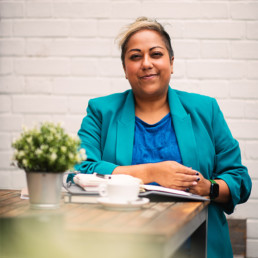
Written by Bennie Kara
Co-Founder of Diverse Educators
Written January 7, 2018.
I am the woman that always has a clothes label sticking out somewhere. In any given day, some kindly person will reach behind me and tuck it in. And I, without fail, will apologise for that label and the fact that someone had to decide what to do with me.
You see, clothes labels are really useful things. They tell you what to do with the item. How to take care of it – how to fix the item if it is damaged in some way. It stays there as a reminder that the item needs to be nurtured. Lots of us become irritated by them – how many times have we cut the label out because we can’t forget it is there – perhaps it’s rubbing against our skin, making us feel uncomfortable. I do it all the time with the vain hope that people will not have to fix me up and make me presentable.
I have made many jokes over the years at various conference about winning the competition on how many labels I have. We categorise people in so many different ways and I have seen it as a laughing matter. So when I was thinking about my labels, I decided to create a pie chart of the make up of me. Mostly just in case my Maths teacher is watching – my Maths GCSE started with 30 mins of me panicking because I had forgotten how to draw a pie chart.
So if you want to see what my clothes label says – this is me.
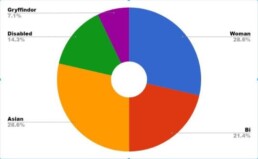
It took a long time to decide how much of me I could allocate to the different labels. I am a woman. Quite considerably so, according the number here. I am also equally Asian. It gets harder when I have to decide just how much of me is on the LBGT spectrum. I define as bisexual and have been in a relationship with a woman for a long time. All of these categories I have become comfortable with – while I know they present me with challenges, I have spent my life getting to know them.
I have come to know myself as a Gryffindor too. This is not in jest. I will not have anyone disagree. I’ve taken the test.
It is my last label that is more recent and perhaps the one I struggle with the most. I learned not long ago that I have hearing loss in both ears and it is more pronounced in my left ear. I will be wearing a hearing aid soon to help me function in loud spaces, to help me understand what people are saying when I can’t see their faces.
I mean, I know I’m a woman and can’t lift heavy things or be in charge of a boardroom. I know that I am Asian and therefore should probably be teaching Science and not English. I know that I am bisexual and this means I am greedy/just not willing to admit I am gay.
But I was not prepared to be disabled, albeit in a small way. In some ways I have to confront here my own misgivings about having a hearing impairment in a profession that is built on listening to children in order to teach them. I sat in a car park and cried. Because this female, Asian, bi person didn’t want another label – especially one that could literally mean people think I cannot do my job. How many glass ceilings for me?
It has taken time to adjust to it. It chafed. I could feel it rubbing. But I have left it there because it gives people another way to know me.
Some people will say: if we take away all labels, we can just be people. I absolutely agree. I want to be able to teach without any of those. At the risk of sounding like a below the line Daily Mail commentator, stop going on about your labels – it creates the victim complex. It’s not important to the way you teach, so just shut up and get on with it. Identity politics creates resentment. I resent you and your labels.
I don’t think any of us walk around with our labels on our sleeves. If teaching is a profession in which your authentic self is required for children and adults alike to connect and know you, if it a profession in which people are the centre then I do not want to lie, either overtly or by omission.
The average 18-44 year old lies twice a day. I am sure that you are sitting there thinking – well that’s low. I can smash that statistic by 9am in the morning on any given school day. But the lies I tell because I have to are now starting to grate.
There are things I can’t say, choose not to say, places I won’t ever visit with my partner – and it is exhausting making all of those decisions about who I can be when I am simultaneously juggling the demands of the curriculum, behaviour, marking, meetings, paperwork. Wouldn’t it just be easier for me and more real for the students if I didn’t have to think about my pronouns so carefully? Or worry about who is going to see me with my partner in the local area?
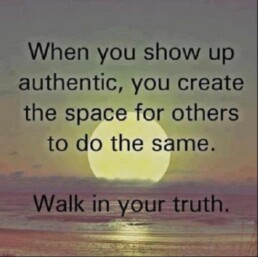
I spoke recently about the curriculum and how having diverse voices delivering content doesn’t take away from what we teach our students – when we teach the Ramayana or about Malian women’s contributions to local industry, we are not saying do not teach about Wordsworth or Dickens. Perhaps as a female, Asian, bisexual, disabled Gryffindor, I can enrich rather than detract. Hiring me, allowing me to be free within a role, means a better education. Not because I am better. But because I can bring my knowledge and still teach yours really quite well. There is enough oxygen for all of our stories, told with pride. Authenticity in teachers allows students to understand humanity in all of its guises. We actively prevent learning when we lie, when we omit.
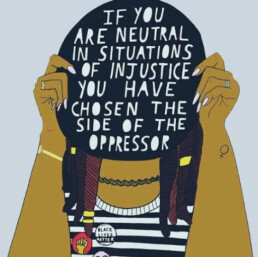
I have seen this quotation many times and it occurs to me that I no longer see it as being about other people. I see it as being about myself and about all of us that walk in different shoes. My silence about about me is collusion. I am colluding with the oppressor. It is unjust that I should be quiet, tuck in my labels to make everyone else feel comfortable, staff, students, parents alike. In remaining silent and not celebrating or sharing all of me as I am, I am complicit.
How can any of these things happen when we are silent?
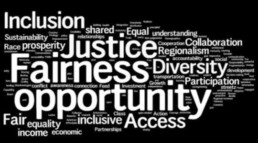
I am not asking anyone to stand up and shout from the rooftops about their sexuality, disability, gender or heritage. But I am asking you to stand, metaphorically speaking. And speak about your truths without fear. And perhaps, when you feel brave enough because you have a room full of people willing to support you – to act, in the way that makes you feel that you are authentic.
So, if you see me again and my labels are sticking out. Maybe don’t tuck them in.
Closing keynote: Diverse Educators Conference, 6th January 2018
